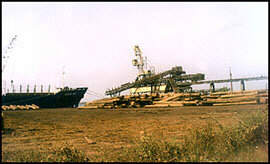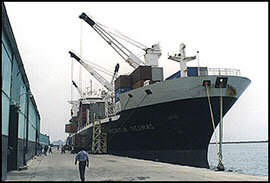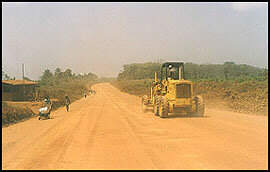 TRANSPORTATION TRANSPORTATION |
The National Port Authority (NPA) is undoubtedly the country's leader in the transportation sector, howbeit only operating in the water transport sub-sector. Other modes of transportation, including land, air and rail, are distant in terms of revenue generation and service-oriented performance.
Notwithstanding, the management of the NPA has been undertaking an evaluation to institute relevant models that will attract capital for port revitalization and development through private investment in key operational areas.
This partnership, the NPA management says, could be pursued through a Built-Operate-Transfer (BOT) arrangement that will ensure the speedy development of port infrastructure, attract traffic and enhance revenue generation for the port.
The NPA was established in 1967 as a state-owned enterprise to manage, plan and develop all ports within Liberia. Today, the NPA is one of Liberia's leading state-owned corporations, operating a network of four ports
The port provides services such as vessels handling, warehousing, and an oil jetty, exclusively for petroleum products. Also, pilotage is compulsory for all vessels entering and leaving the various ports, while towage facilities are available for all classes of vessels calling at the various ports.
The Freeport of Monrovia, located in the nation's capital, is the largest port in the NPA network. It was built by the United States military during World War II. The Freeport handles most of the cargoes imported into Liberia.
Two breakwaters (2,350m and 2,200m long) protect the harbor enclosing a basin of 300 hectares of protected water. The general cargo berths (main pier) consist of an open piled, 610m long by 11m wide marginal wharf with a reinforced concrete deck. The main wharf serves coastal and main line vessels of the 2nd and 3rd generation.
The other three out-ports, located in Buchanan, Greenville and Harper, cater to mainly export trading and a small movement of passenger vessels.
The Port of Buchanan, located some 170 miles southeast of Monrovia, is the second largest within the NPA network. It was constructed in 1960 to export iron ore from the Nimba Range in the north of the country. Two breakwaters, 1,890m and 590m long, are protecting the harbor. Inside the basin, a 255m long ore-loading quay is located adjacent to the deeper section of the harbor basin with a water depth of 12.95m below chart datum. This port recorded a decrease in 1999 of nine percent in the number of vessels calling there as compared to 1998.
Adjacent to the loading quay, a waiting berth for ore carriers is available, while on the inner side of the secondary breakwater, a commercial quay, 334m long, is located with an available water depth of 10.15m below chart datum. The access channel to the port provides ships a water depth of 14.95m below chart datum and a channel width between the breakwaters of 210m.

The multi-million dollar logging concern called OTC runs the Buchanan port under a lease agreement with the NPA primarily to export its logs. The company had undertaken dredging and rehabilitation as part of the sub-letting arrangements.
The ports of Greenville and Harper are somewhat smaller and cater mainly for export of logs and timber from the southeast of the country. They, however, provide means for access to the outside world for other export-oriented industries, preferably in the agricultural sector, utilizing Liberia's rich soil.
The four ports, during the year 1999, netted a total cargo throughput of 713,407.53 metric tons, indicating a 23% increase when compared to the 579,955.7 metric tons handled in 1998. For container trade 18,024 TEUs were handled, reflecting a 5% increase over the previous year.
Remarkable progress was also recorded in the vessel turn around time (TAT) due largely to the infusion of new and rehabilitated equipment, including top lifts, empty lifts and forklifts, into the system. A positive shift in delay from 4382.01 hour inefficiency to 4000.74 inefficiency as compared to 1998 was recorded. | "We are second to none on the West Coast as regards our turn around time. We have been able to repair 90% of the equipment that had broken down. It has involved some spending, but it was necessary to keep the port and the national economy viable," says Mr. Alphonso Gaye, Managing Director of the NPA.

Mr. Gaye also points out that the Freeport of Monrovia is still the principal gateway to neighboring markets. He says: "Over the last few months, transshipping and our former partners have been coming back. We are also managing the overflow from Ivory Coast and a lot of Sierra Leone."
The port has been restored to a 24-hour port of call, while management has been busying itself building container parks, new roads within the port, warehouses for cargoes, log yard and a plaza in the confines of the port for shipping agencies offices.
The management of the National Port Authority plans to carry out a capital dredging of the Freeport of Monrovia to address the high level of siltation, approaches and basin to return the port to its original designed depth of 15 meters. Boskalis Westminster, a Dutch company has estimated the dredging of the Freeport of Monrovia at about 1,5 million USD.
There is a lot of goodwill out there to lend a helping hand in the processes of privatization of the state-owned parastatals to create a favorable environment that would stimulate both the domestic private sector and the international private sector.

"Institutions like the World Bank and us (European Commission) would like to help the government achieve this clear enabling environment by providing our assistance and our advising guidance as to how it (privatization) should be done," says Mr. Brian O'Neill, Chargé d'Affaires to the office of the European Commission in Liberia.
"…Yes I believe there are some long-term possibilities for somebody who wants to get involved. They (public corporations) all had some contacts at some point with the private sector, and the private sector is the future," Mr. O'Neill points out.
Land transport continues to be the most widely used mode of commuting in Liberia and offers vast opportunities to those with tenure and experience in this sector to invest.
"We would like to take private sector role in transportation one step further - to private ownership, management and maintenance of most of the infrastructures," says the Minister of Transport, Mr. Francis M. Carbah.
This is actually breaking away from the age-old tradition wherein government controlled the various aspects of the transportation sector like public land transport, domestic and international airports and the seaports.
Minister Carbah says the government is extending an invitation to private investors to participate in the reconstruction of the transport sector. It envisages projects like public transport terminals fitted with transit and cargo facilities, shopping center, vehicle service stations to cater for cross-country road commuters.
Rehabilitation of local airports to include improvement of runways, flight communication equipment as well as development of the country's navigable waterways are among the opportunities for investment in the transport sector. |

